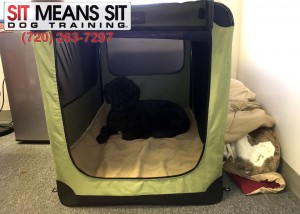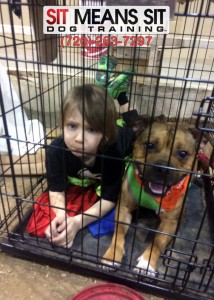It is always interesting and a bit frustrating to me when I hear people say they think putting their dog in a crate is “mean”. Or when people are lucky enough to have a crate-trained puppy, when the dog “gets old enough” they remove the crate from the dog’s life! Crates, unless used incorrectly, are a good thing for dogs! They like them and there are benefits for you.
Why Crate Train A Dog or Puppy?
There are lots of reasons to crate train your puppy or dog including:
Aiding with potty training
Believe it or not, house training is one of the easiest things to teach a dog because dogs are clean by nature and don’t like to soil their sleeping area. So by managing their “den”, they’ll learn to signal when they want out to do their business.
Help confine your puppy or dog if she is injured
Unfortunately dogs can get injuries or ailments that require them to be confined. Being injured or sick is stressful enough for a dog and if they also need to be put in a crate/kennel for the first time in their life that will just add to their stress. However, if the dog sees his crate as his home, then he will naturally want to spend time there when he is not feeling well.
Keep your house/belongings “safe”
In case you haven’t discovered, puppies like to chew and get into things! If they are left to wander too early in their life they are very likely to do things you consider bad. Of course the puppy is not doing anything bad on purpose, but they don’t yet know the things she is allowed/supposed to do.
Your dog’s safe place/bed is portable for travel
Traveling with your dog is much simpler with a crate and, very likely required when staying in a hotel.
Give your puppy and dog a safe place
To me, this is the most important one. A dog should have a place all their own. A place they can feel safe and not be bothered by other dogs, people, kids, etc. Dogs are den animals, and unless they are introduced to a crate wrong, the crate is a very comfortable den-like environment. For example, when you’ve got a lot of company, possibly with playful children, a dog can escape the turmoil for a nice nap in their crate. Or, an older dog with a new puppy will play with the puppy, however, when they’re done and the puppy wants to keep going, the older dog can go to his/her kennel to sleep in peace.

Get the Size Right
If the crate is too big for your puppy, she will be more likely to eliminate in a corner of the crate, away from where she sleeps. You want to get a crate that is small enough to feel like a bed so this does not happen! It is good to get a crate that can expand in size. A lot of crates for sale today will have a separator section where you can expand the area the dog can access as she grows.
Especially with adults, it is even more important to ensure the crate is large enough for your dog. Your dog must at least be able to stand up comfortably and turn around.
The crate should be a safe and happy place for your dog – not punishment. Keep it positive and treats are a good idea when teaching a dog to crate!
How NOT to Use a Crate
A crate should not be used for punishment!
It should be a place the puppy or dog wants to go to and will go to on their own. Not only will punishment make them not like the crate, it is pointless, as a dog does not understand punishment. They do understand when you are mad, when they are scared, etc. But punishment only scares them. It is much better to redirect energy and train your dog. You and the dog will be happier and have a much better relationship. A lot of people think they can punish the dog because the “dog knows he did something wrong, he looks guilty.” There has been a lot of research on this subject, and everything I have seen and read shows that dogs do not feel guilt. They do feel fear and some are very good at sensing when their owners are or will be unhappy.
A crate should not be used to confine your dog for long periods of time
Also, if you must crate your adult dog when you leave home, a good rule of thumb is never leave him confined for more than six hours without a break. If you need to be gone longer, arrange for someone to come to the house and let him out for a potty and exercise break.
Understand, when you get a puppy you need to figure out a schedule to let the dog out every two to three hours for the first few months.
Crate Training Your Young Puppy
The goal here is to NEVER allow your puppy to soil his/her crate. True, accidents happen, but we do everything we can to avoid it.
Puppy + Crate Can Take Some Time
This can be a challenge. There is a problem with a young puppy – we want to ensure the crate is a safe and happy place, however, when you very first get a puppy, the only “safe and happy place” for the puppy is in your arms. However DO NOT let the puppy sleep in your bed with you! Often the first couple nights with a puppy are crucial for getting the dog to be comfortable away from you, and they are going to be a bit sleepless for you and the puppy! Just understand that and prepare for it. If you get a brand new puppy (e.g. 8-10 weeks old or so) the first night with you is very likely his first night away from his siblings and he is going to be lonely and he will not understand what is going on.
In a perfect world, he would already be used to a crate, but that is not always the case (in fact, it is rarely the case). But you also have to sleep. With every puppy I have had, they sleep in a box or other open-topped confinement that is no larger than their crate (more on this later) next to my bed. If he cries (and I know he’s been out in the last two hours), I will put my hand or arm in the box so he knows I am there, then I remove my arm. Repeat as needed throughout the night, sigh. Don’t be too doting or coddle your puppy. This will only reinforce the behavior and he’ll cry even more. If verbal and physical comfort with your hand/arm fails to quiet him, ignore it, don’t offer more! Tough love may be difficult, but eventually your puppy will learn that crying at night will get him nowhere. The more persistent you are in your approach, the quicker the situation will be resolved. This only usually lasts for a couple of nights. Be consistent! If you’re stern one minute and sympathetic the next, your puppy will only be confused and the fussing and crying will continue.
If your puppy quiets and then wakes crying and it’s been longer than two hours since he’s gone potty, you need to immediately scoop him up and take him out to his potty place. (Don’t trust him to walk himself, because he’ll squat before you get there!) Puppies have small bladders and need to go out often – every 2 to 4 hours. Remember to take away food and water at about 7:00 in the evening so that he is running on empty at bedtime. Oh, and take him out before bed!
Some people say a radio or other soft noise will help – and it can depend on the puppy. I have also seen where wrapping a ticking clock (an old analog alarm clock) in a towel and putting that in the box helps.
Don’t forget to let the puppy outside to go potty first thing in the morning!
Graduate to the Crate
I use a box during the first nights because I always want the crate to be a safe happy place. You need to set aside time over the first few days to work on the crate so the dog can graduate from the box as soon as possible. Do this by:
- Leaving the door open, put a treat in the crate, and let the puppy go in and retrieve the treat – don’t close him in. Do this throughout a day.
- Next put the treat in and keep the puppy in the crate with your hand. Again, if he does cry, whine or bark, wait for a few seconds of calm before letting him out. But if you do this correctly and slowly the puppy should be fine with it.
- Finally, start to put the treat in and close the door for just a moment and then let him out. Again, if he does cry, whine or bark, wait for a few seconds of calm before letting him out. But if you do this correctly and slowly the puppy should be fine with it. Slowly increase how long you shut the door for.
- It’s nice to prop the crate door open when not in use so your dog can access it whenever he wants. And he will!
Crate Training Your Older Puppy or Dog
How to Introduce an Older Puppy or Dog to a Crate
It is about the same as with a puppy graduating to a crate (above). If the dog has had a bad experience with a crate though, it may take more time and patience, so hang in there! Be firm but keep it as positive as possible.
Again, the goal here is to NEVER allow your dog to soil his/her crate. True, accidents happen, but we do everything we can to avoid it. So even with a tiny dog, do not teach a dog to go to the bathroom in the crate – e.g. don’t put potty pads in the crate. If you do this, and the dog learns to eliminate in his crate, you are going to have a much more difficult time housebreaking your dog!

